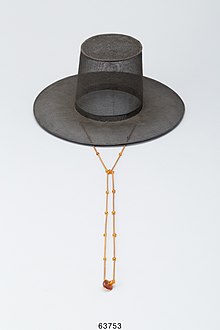Gat (hat)
| Gat | |
 | |
| Korean name | |
|---|---|
| Hunminjeongeum | 갓 |
| Revised Romanization | gat |
| McCune–Reischauer | kat |
A gat is the name of Korean traditional hat worn by men along with hanbok (Korean traditional clothing) during the Joseon period. It is made from horsehair with a bamboo frame and is partly transparent.
Most gat are cylindrical in shape with a wide brim on a bamboo frame. Before the late 19th century, only noble class men could wear gat, which represented their social status and protected their topknots (Korean: 상투; RR: sangtu).
Artisans who make gat are called ganniljang (갓일장), from gannil (갓일, a compound of two words gat and il (work); "gat making") + jang (Korean: 장; Hanja: 匠 "artisan, craftsperson, master of a craft").[1] As gannil requires artisanship throughout a complex series of techniques involving an array of materials, it has been designated as Intangible Cultural Property No. 4 on December 24, 1964.[2]
History[]
The origins of gat date back to ancient times. Usually, the following hats are considered to be the first specimens of what is known as gat today: the so-called iphyeong baekhwa pimo (Korean: 입형백화피모; Hanja: 笠形白樺皮帽) from Geumnyeongchong (Korean: 금령총; Hanja: 金鈴塚), an ancient Silla tomb located in Gyeongju, and the pan-shaped gat which is distinct from ordinary hats in pattern and shape and is depicted on the murals of the Gamsinchong (Korean: 감신총; Hanja: 龕神塚), an ancient Goguryeo tomb.

Colors and types[]
Colors and types of gat were differentiated by circumstances and/or social status.
During the Joseon period, black gat (Korean: 흑립; Hanja: 黑笠; RR: heungnip) were restricted to men who had passed the gwageo, or civil service examinations. In narrow definition, the term gat refers to the heungnip.


A white gat (Korean: 백립; Hanja: 白笠; RR: baengnip) was worn during times of national mourning. It is crafted in the same manner as a black gat except that its finish is done with sambe which makes it white.[3]

A red gat (Korean: 주립; Hanja: 朱笠; RR: jurip) was worn by military officers of Joseon. Its color comes from red lacquer.[4]
Commoners wore a variant called paeraengi (패랭이) which was woven from split bamboo.[5]


Presence in cultural industry[]
In South Korean TV series Kingdom from 2019, gat is worn by the actors to represent each character's social class.[6]
See also[]
- Hanbok
- Korean culture
- List of Korea-related topics
- Manggeon
Notes[]
- ^ "Ganniljang (갓일장)". SNU PRESS.
- ^ "Gannil (Horsehair Hat Making)". Cultural Heritage Administration.
- ^ "White Gat 백립(白笠)". Encyclopedia of Korean Culture.
- ^ "Red Gat 주립(朱笠)". Encyclopedia of Korean Culture.
- ^ "패랭이". naver.com. Retrieved 2 November 2015.
- ^ "Fancy hats in Netflix Korean Zombie series "Kingdom"".
External links[]
| Wikimedia Commons has media related to Gat. |
- Gat, Traditional Headgear in Korea by the National Research Institute of Cultural Heritage
- "Master Artisan of Horsehair Hat Making" (in Korean)
- "Gat, Encyclopeida of Korean Culture" (in Korean)
- Hats
- Korean headgear
- Korea stubs